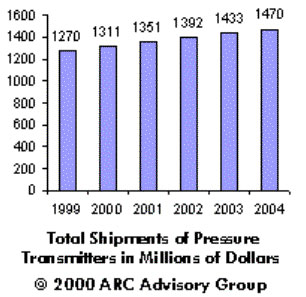ARC Advisory Group says pressure transmitter market stagnates
With an annual growth rate much lower than previously expected, this mature commodity market demands product and distribution channel innovation to achieve improved revenue growth. One key reason for this change in market dynamics is the full-scale assault from new technologies and processes that make the traditional role of the stand-alone pressure transmitter all but obsolete.
"The pressure transmitter market is migrating toward two classes, commodity and value-added," says ARC Senior Analyst Wil Chin. "The significant benefits of new multivariable transmitters are predicted to help sustain the growth of the pressure transmitter market, along with the increased acceptance of and migration to Fieldbus capabilities."
However, Chin notes that suppliers are not standing idly by as other technologies encroach upon them. "Instead, they are incorporating these technologies and offering value-added multivariable measurements packaged with primary flow elements for specific applications," he says.
A few examples of these are: DP Transmitter/Orifice, DP Transmitter/Annubar, or DP Transmitter/Wedge. This is further evidence of the need for suppliers to embrace strategic issues to remain competitive.
"As users understand the added benefits of smart transmitters, the role of the conventional transmitter is predicted to decline significantly within the forecast period," Chin says. "The marketplace is expected to become a two-tiered arena: smart and low cost. Users are expecting more and more from even low cost transmitters, and suppliers have responded by developing more advanced sensors."
The industries that are expected to have the highest growth rates are food & beverage, power, chemical, and pharmaceutical to meet the increasing demand for product quality and cost reduction while adhering to the strict standards for promoting the increased automation of processes.
Regionally, as Latin America's heavy industries shift their focus to industrial control systems, this region is viewed as having substantial untapped potential and will witness the highest growth through 2004. The Asian markets also represent areas for high growth because they increase investment in industrial automation and are recovering from their recent financial crisis.

Edited by Jim Lardear
Managing Editor, PlantAutomation.com
